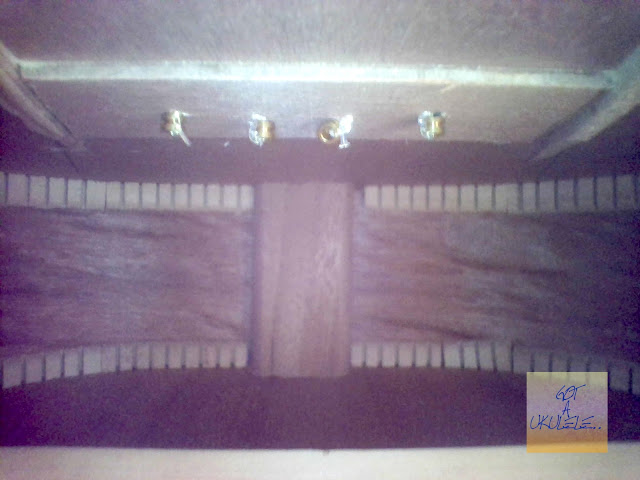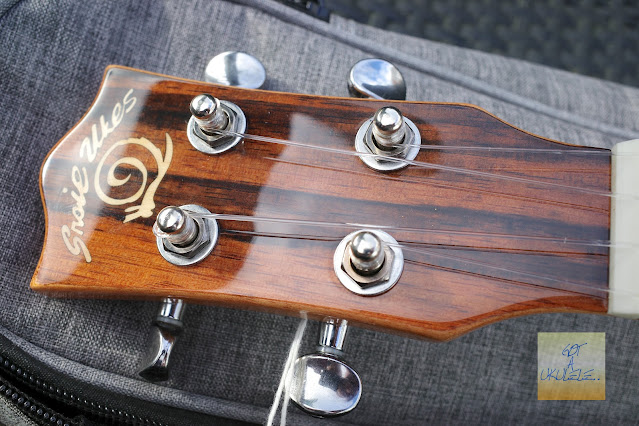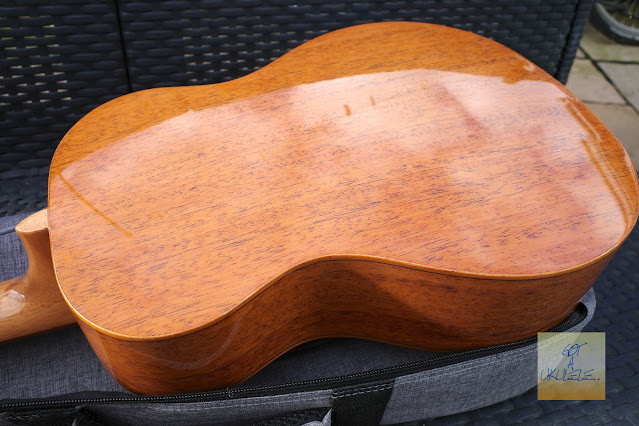Time for a ukulele scale that I don't feature enough on Got A Ukulele (not for lack of trying). This is the Snail SUB-M1 Baritone - an instrument where all is not quite as it seems.
Snail have been around for a few years now and are a well known brand that have always done reasonably well on my reviews. I've never looked at one of their big guns though, and this is a baritone from the brand at the more entry level spec level that caught my eye.
SUMMARY VIDEO REVIEW
The bridge is the common 'batwing' shape used by Snail in their other instruments and is a through body style for stringing. It's listed as being made from ebony (though more on that later on) and is pretty tidy in the finish. Sitting in that is a compensated bone saddle and the spacing there is 42mm.
There is no other decoration here bar a simple abalone sound hole ring and wooden edge binding and tail stripe which, in view of the larger real estate leaves it looking a bit empty to my eyes. I'm not sure there is much more that could be done - maybe a clearer binding around the top to lift it, but it clearly has been cut down to keep the price lower. Hey, decoration makes no sound so no biggie I guess. The body is then finished in a gloss which is on the thick side, but I have seen far worse even though it is pooling a little around the fingerboard end.
Inside is tidy with notched linings and braces that are not overly thick. The top is vertically braced with two supports on the lower bout either side of the bridge plate.
The neck wood is not specified but is a lot paler than the body and is also glossed. It's made from three pieces with very obvious joints at the heel and headstock. What's most disappointing is that whilst the profile at the nut flattens off quite nicely it has a distinctly average 35mm nut width, 27mm between the outer strings.. for a baritone. I know it's not a hard and fast rule, but as scales get bigger, brands do tend to increase the nut size a bit. Take the Flight Fireball Baritone - that has a 38mm nut. I've played sopranos with more space than this and it immediately puts me off.
Topping that is a fingerboard listed as ebony like the bridge, but looking more closely at it, I think it's re-constituted wood as I can see the layers in it. If that's the case they really should say so. It's edge bound in brown wood hiding the 20 frets joined at the 14th and also meaning there are no sharp edges. Simple pearl position dots face out at the 5th, 7th, 10th, double 12th and 15th and they are paired with side dots. At the top end is a bone nut which, whilst having a decent action is far too angular on the ends and is positively painful on the hand if you butt up against it in first position. It really does need dressing back.
Topping that is a fingerboard listed as ebony like the bridge, but looking more closely at it, I think it's re-constituted wood as I can see the layers in it. If that's the case they really should say so. It's edge bound in brown wood hiding the 20 frets joined at the 14th and also meaning there are no sharp edges. Simple pearl position dots face out at the 5th, 7th, 10th, double 12th and 15th and they are paired with side dots. At the top end is a bone nut which, whilst having a decent action is far too angular on the ends and is positively painful on the hand if you butt up against it in first position. It really does need dressing back.
The headstock is the similar pseudo crown shape Snail have used before, nicely faced in some ebony veneer in their usual style that just falls short of the edges to give it the effect of a touch of binding or relief. On this example the ebony is stripy and quite pale in places which I really like, though bear in mind some others I have seen photographs of have much darker ebony here. The usual Snail logo is a wooden inlay in the top face, and as I have said before the word 'Snail' doesn't actually read 'Snail' at all, rather 'Snoie'. I've never understood why they haven't tidied this, but maybe they don't read these reviews!
The tuners are Snail branded sealed gears in chrome. Whilst I'd always prefer open gears rather than guitar tuners (on weight grounds), these are less noticeable on a bigger uke like a baritone. They are a bit cheap feeling to use though with some odd jumpiness on turning them and varying tensions.
Finishing it off are a set of unspecified strings that feel like clear nylon and a decent branded padded gig bag. And the UK list for these is circa £219.99 which is clearly not a lot and is often discounted to below £200.
But..... those strings... this comes as standard in C tuning... and C tuning with a HIGH G. What? On a baritone? Perhaps I am going to make too much of this and I appreciate tuning is a totally subjective thing and lots of people like to tune baritones in tenor tuning.. but as the standard offering out of the box? Personally I find different uke scales suit different tunings and the regular DGBE works FAR better for my ears on a baritone than GCEA to fatten out the breadth of tone the bigger body can deliver. I simply don't get this as being the standard choice. OK, some specialist uke dealers are offering a change to G tuning included in the price, but not all. You could buy this expecting a G tuning baritone and you may end up having to spend more on a string change (and possibly adjust the intonation too). Add in the soprano width nut and it makes me wonder whether Snail actually know what a baritone ukulele actually is?
So some gripes / questions / confusion on my part. Thankfully the build, finish and setup are decent enough (bar that sharp nut). It's not a heavy instrument either at 710g though despite the guitar tuners this is actually body heavy. I'd rather that than a neck dive, but it's still not right.
Volume and sustain first and whilst neither are what I would call poor they are both just distinctly average. Volume wise it sounds like something is constraining or muting it, particularly up the neck but even just in first position strums it still needs a lot of effort. Sustain too is also low and dies off quickly which is really not what I would want or expect from a bigger body. It sounds like a much smaller instrument.
And then the tone - well this is a challenge for me as it's not tuned how I would 'expect' a baritone to sound. The tone, whether strummed or picked is bright and clear giving it a jangly peppy sound that is even more concert sounding to me than even tenor sounding. And that's just odd to me. There's not much breadth of depth to the tone at all. What it sounds like to me is a just above average middle ground cheaper tenor or concert and certainly not with a baritone voice. Is that a bad thing? Well plenty of people like their baritones tuned in C tuning so people may like it, but my point here is that even if I am comparing it to instruments in tenor scale this wouldn't be a stand-out either. I like the clarity and chime it has, but coupled with the lower than average sustain it's too staccato for me on such a big instrument. Why?
So this has been a hard one for me to sum up. It's well built enough, but the nut width is really not for me. The tone is clear and bright, but I am not convinced that's a positive for a baritone, particularly with the lower sustain. Sure you could change them, but I simply think it should come in G tuning from the off. I really wasn't sure how to adjust the scoring for this so I've cut back the fit and finish score for the nut, tuners and string choice (because the latter is deliberate). I've also trimmed the sound score back because, whilst it's a nice enough tone, it's still just average even if it was a tenor and it's certainly not a baritone sound so i've judged it mainly on that. The score would be higher if it was a tenor on this aspect, but still not stellar either! Nothing is perfect in scoring though and if you could be bothered to change the strings then i'm sure this is a good value for money option on a no frills baritone. It's a nice enough instrument, but i'm just asking myself 'why' too many times with this one.
UKULELE SPECS ROUNDUP
Model: Snail SUB-M1
Scale: Baritone
Body: Laminate mahogany
Bridge: Ebony, through style
Saddle: Compensated bone
Spacing at saddle: 42mm
Finish: Gloss
Neck: Mahogany?
Fingerboard: Ebony?
Frets: 20, 14
Nut: Bone
Nut: Bone
Nut width: 35mm, 27mm G to A
Tuners: Snail branded sealed gears
Strings: Unspecified (clear nylon?) in high GCEA
Strings: Unspecified (clear nylon?) in high GCEA
Extras: Gig bag
Weight: 710g
Country of origin: China
Price: £219.99
UKULELE PROS
Decent enough build and finish
Simply but classy look
Clear, bright tone
UKULELE CONS
A little plain for some?
35mm nut on a baritone?
Sharp nut
High G tuning on a baritone?
Cheap tuners
Volume and sustain a little muted?
Those positives on tone are not baritone positives for me
Those positives on tone are not baritone positives for me
UKULELE SCORES
Looks - 8 out of 10
Fit and finish - 7.5 out of 10
Sound - 7 out of 10
Value for money - 9 out of 10
OVERALL UKULELE SCORE - 7.9 out of 10
UKULELE VIDEO REVIEW
GOT A UKULELE IS NOT PAID BY BRANDS OR SHOPS - YOUR KIND DONATIONS ARE WHAT KEEP THE SITE GOING! THANKS FOR YOUR HELP!
SAY THANKS WITH A BEER!
BECOME A GOT A UKULELE PATREON
OR THRU PAYPAL
THANKS!











Baz, I completely agree with you about the nonsensical use of thin plastic strings tuned gCEA on this baritone body. The body is large to resonate with lower pitches that standard DGBE-tuned strings would provide. If I had ordered this instrument sight-unseen by online purchase, I would send it right back.
ReplyDelete